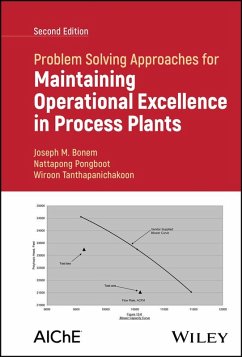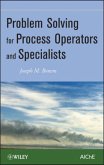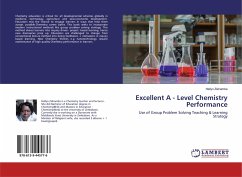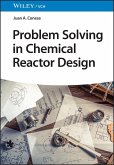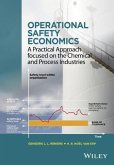Joseph M Bonem, Nattapong Pongboot, Wiroon Tanthapanichakoon
Problem Solving Approaches for Maintaining Operational Excellence in Process Plants
Joseph M Bonem, Nattapong Pongboot, Wiroon Tanthapanichakoon
Problem Solving Approaches for Maintaining Operational Excellence in Process Plants
- Gebundenes Buch
- Merkliste
- Auf die Merkliste
- Bewerten Bewerten
- Teilen
- Produkt teilen
- Produkterinnerung
- Produkterinnerung
Comprehensive reference providing methods for process engineers and operators to solve challenging process problems and develop working hypotheses for typical process equipment Problem Solving Approaches for Maintaining Operational Excellence in Process Plants provides a template for achieving an enhanced level of operating efficiency in chemical processing plants and refineries. With examples included throughout to demonstrate key concepts, this book includes methods for formulating working hypotheses for typical process equipment such as pumps, compressors, heat exchangers/furnaces,…mehr
Andere Kunden interessierten sich auch für
![Operational Excellence Operational Excellence]() John S. MitchellOperational Excellence82,99 €
John S. MitchellOperational Excellence82,99 €![Problem Solving for Process Operators and Specialists Problem Solving for Process Operators and Specialists]() J. M. BonemProblem Solving for Process Operators and Specialists115,99 €
J. M. BonemProblem Solving for Process Operators and Specialists115,99 €![Geotechnical Problem Solving Geotechnical Problem Solving]() John C. LommlerGeotechnical Problem Solving183,99 €
John C. LommlerGeotechnical Problem Solving183,99 €![Excellent A - Level Chemistry Performance Excellent A - Level Chemistry Performance]() Hellyn ZishambaExcellent A - Level Chemistry Performance26,99 €
Hellyn ZishambaExcellent A - Level Chemistry Performance26,99 €![Problem Solving in Chemical Reactor Design Problem Solving in Chemical Reactor Design]() Juan A. ConesaProblem Solving in Chemical Reactor Design90,99 €
Juan A. ConesaProblem Solving in Chemical Reactor Design90,99 €![Managing Worker Safety and Health for Excellence Managing Worker Safety and Health for Excellence]() Margaret R RichardsonManaging Worker Safety and Health for Excellence188,99 €
Margaret R RichardsonManaging Worker Safety and Health for Excellence188,99 €![Operational Safety Economics Operational Safety Economics]() Genserik L. L. ReniersOperational Safety Economics142,99 €
Genserik L. L. ReniersOperational Safety Economics142,99 €-
-
-
Comprehensive reference providing methods for process engineers and operators to solve challenging process problems and develop working hypotheses for typical process equipment Problem Solving Approaches for Maintaining Operational Excellence in Process Plants provides a template for achieving an enhanced level of operating efficiency in chemical processing plants and refineries. With examples included throughout to demonstrate key concepts, this book includes methods for formulating working hypotheses for typical process equipment such as pumps, compressors, heat exchangers/furnaces, fractionating towers, and reactors, with additional information on defining and setting metrics and the application of the techniques in unusual situations, as well as the application of these techniques in view of commercially available computer simulation programs. This book covers topics including initial considerations in problem solving, basic steps in problem solving, and verification of process instrument data, with solved problems showing how techniques can be applied to prime movers, plate processes, kinetically limited processes, and unsteady state problems. This newly revised and updated Second Edition includes coverage of the latest research and developments in the field. Written by a team of highly qualified industry professionals, Problem Solving Approaches for Maintaining Operational Excellence in Process Plants includes discussion on: * Lumped parameters as the ideal approach to determine values for key performance indicators (KPIs) * Theoretical KPIs in comparison to actual operation as a method to find "hidden problems" * Situations where experience-based solutions are unavailable due to lack of technically trained personnel * Solutions to problems where a previous analysis has confirmed a need for new equipment or enhanced operating procedures * Digital twins and their usefulness in predicting yields, executing plant operations, and training operating and technical personnel Problem Solving Approaches for Maintaining Operational Excellence in Process Plants is an essential reference on the subject for chemical engineers, industrial engineers, process operators, process shift supervisors, chemical engineers with minimal exposure to industrial calculations, and industrial managers who are looking for techniques to improve organization problem solving skills.
Hinweis: Dieser Artikel kann nur an eine deutsche Lieferadresse ausgeliefert werden.
Hinweis: Dieser Artikel kann nur an eine deutsche Lieferadresse ausgeliefert werden.
Produktdetails
- Produktdetails
- Verlag: Wiley
- 2nd edition
- Seitenzahl: 400
- Erscheinungstermin: 22. Januar 2025
- Englisch
- Abmessung: 229mm x 152mm x 22mm
- Gewicht: 703g
- ISBN-13: 9781394207152
- ISBN-10: 1394207158
- Artikelnr.: 67658177
- Herstellerkennzeichnung
- Libri GmbH
- Europaallee 1
- 36244 Bad Hersfeld
- gpsr@libri.de
- Verlag: Wiley
- 2nd edition
- Seitenzahl: 400
- Erscheinungstermin: 22. Januar 2025
- Englisch
- Abmessung: 229mm x 152mm x 22mm
- Gewicht: 703g
- ISBN-13: 9781394207152
- ISBN-10: 1394207158
- Artikelnr.: 67658177
- Herstellerkennzeichnung
- Libri GmbH
- Europaallee 1
- 36244 Bad Hersfeld
- gpsr@libri.de
Joseph M. Bonem is an engineering consultant specializing in the area of polymers with prior experience at ExxonMobil Chemicals in the fields of elastomers and plastics. Nattapong Pongboot is a chemical engineer with hands-on experience in refining and petrochemical technologies. He is a Project Manager under the Refinery Catalyst Testing group at Avantium R&D Solutions. Wiroon Tanthapanichakoon is a process engineering consultant, engineering training business owner, and the CEO of Global R&D Co. Ltd., Thailand.
Preface xi
1 Focus of Book 1
1.1 Introduction 1
1.2 Metrics and KPIs 2
1.3 Finding Hidden Problems 3
1.4 Experience-Based Solutions 4
1.5 Achieving and Maintaining Operational Excellence 5
2 How to Achieve and Maintain Operational Excellence 7
2.1 What is Operational Excellence? 7
2.2 What is the Value of Operational Excellence? 8
2.3 What are the Limitations to Achieving and Maintaining Operational
Excellence? 11
2.4 Achieving and Maintaining Operational Excellence 11
3 Initial Considerations 15
3.1 Introduction 15
3.2 An Electrical Problem 17
3.3 A Coffeemaker Problem 18
3.4 Applications of Concepts to Plant Problem Solving 21
3.5 Limitations to Problem Solving in Process Plants 24
4 Successful Plant Problem Solving 29
4.1 Introduction 29
4.2 Finding Problems with a Daily Monitoring System 29
4.3 Solving Problems with a Disciplined Learned Problem-Solving Approach 36
4.4 Determining the Optimum Technical Depth 42
4.5 Using the Directionally Correct Hypothesis Approach 47
5 Examples of Plant Problem Solving 49
5.1 Industrial Examples 49
5.2 Polymerization Reactor Example 49
5.3 Application of the Disciplined Problem-Solving Approach 51
5.4 Lessons Learned 55
5.5 Multiple Engineering Disciplines Example 56
5.6 Application of Disciplined Problem-Solving Approach 57
5.7 Lessons Learned 62
5.8 A Logical, Intuitive Approach Fails 63
5.9 Lessons Learned 65
Nomenclature 65
6 Development of Working Hypotheses 67
6.1 Introduction 67
6.2 Areas of Technology 67
6.3 Formulating Hypotheses Via Key Questions 68
6.4 Beauty of a Simplified Approach 71
6.5 Verification of Proposed Hypotheses 71
6.6 One Riot-One Ranger 73
7 Application to Prime Movers 75
7.1 Introduction 75
7.2 Kinetic Systems 75
7.3 Pump Calculations 78
7.4 Centrifugal Compressor Calculations 80
7.5 Displacement Systems 82
7.6 Displacement Pump Calculations 85
7.7 Calculations for Positive Displacement Compressors 87
7.8 Problem-Solving Considerations for Both Systems 89
7.8.1 Compressors 89
7.8.2 Pumps 91
7.9 Example Problem 7.1 92
7.10 Lessons Learned 98
7.11 Example Problem 7.2 99
7.12 Lessons Learned 103
7.13 Example Problem 7.3 104
7.14 Example Problem 7.4 104
7.15 Lessons Learned 109
7.16 Example Problem 7.5 109
7.17 Example Problem 7.6 111
7.18 Lessons Learned 118
7.19 Example Problem 7.7 118
7.20 Lessons Learned 124
7.21 Example Problem 7.8 125
7.22 Lessons Learned 131
Nomenclature 131
8 Application to Plate Processes 135
8.1 Introduction 135
8.2 Fractionation with Sieve Trays 135
8.3 Problem-Solving Considerations for Fractionating Towers 139
8.4 Development of Theoretically Sound Working Hypotheses 140
8.5 Problem-Solving Reboiler Circuits 142
8.6 Example Problem 8.1 145
8.7 Lessons Learned 154
Nomenclature 154
9 Application to Kinetically Limited Processes 155
9.1 Introduction 155
9.2 Kinetically Limited Models 155
9.3 Limitations to the Lumped Parameter Approach 158
9.4 Guidelines for Utilization of this Approach for Plant Problem Solving
159
9.5 Example Problem 9.1 160
9.6 Lessons Learned 167
9.7 Technique for Estimating Polymer-Volatile Equilibrium 168
9.8 Example Problem 9.2 169
9.9 Lessons Learned 174
9.10 Example Problem 9.3 175
9.11 Lessons Learned 183
Nomenclature 184
10 Application to Unsteady State 187
10.1 Introduction 187
10.2 Approach to Unsteady State Problem Solving 188
10.3 Example Problems 189
10.4 Problem 10.1 189
10.5 Lessons Learned 196
10.6 Example Problem 10.2 197
10.7 Lessons Learned 204
10.8 Final Words 205
Nomenclature 206
11 Application to Other Plant Improvements 209
11.1 Introduction 209
11.2 Debottlenecking Reactors 210
11.2.1 Kinetics 210
11.2.2 Heat Removal 211
11.2.3 Stepwise Procedure 211
11.2.4 Real Life Example 212
11.2.5 Macro Heat Removal 212
11.2.6 Micro Heat Removal 213
11.3 Real-World Hydraulic Debottleneck 216
11.3.1 Introduction 216
11.3.2 Always Account for Non-idealities 217
11.3.3 A Quick Guide for a Successful Hydraulic Test Run 218
11.3.4 A Recommended Workflow for an Effective Hydraulic Revamp 220
11.3.4.1 Utilize Equipment/Device's Characteristics 220
11.3.4.2 Use a Calibrated Hydraulic Model 221
11.3.5 Maximize Diesel Production by Revamping the Draw-off System 222
11.3.6 A New Feed Preheater for Energy Saving 224
11.3.7 Increase Wash Water Flow to Reduce the Corrosion Rate 227
11.3.8 Improve Diesel Recovery from a Crude Distillation Column 228
11.3.9 Other Considerations 230
11.4 Debottlenecking By Improving Operating Procedures 232
11.4.1 Improving Water Clarification 232
11.4.1.1 Introduction to Water Clarification 232
11.4.1.2 Sand Filtration Basics 233
11.4.1.3 Evaluate Backwash Performance 235
11.4.1.4 Operational Issues Related to Inefficient Backwash 236
11.4.1.5 Field Techniques for Backwash Tuning 238
11.4.1.6 A Real-World Example 241
11.4.1.7 Other Tips 242
11.5 Trust Creating a Disaster-Heat Exchanger Corrosion from Improper
Cooling Water System Operation 243
11.5.1 Background 243
11.5.2 Penny Wise, Pound Foolish-Misconception of Cooling Water System
Operation 245
11.5.3 Take Ownership 251
Nomenclature 251
12 Applications of Novel Process Engineering Fundamentals to Plant Problem
Solving 255
12.1 Introduction 255
12.2 Novel Approaches to Plant Problems 255
12.3 Mostly used Engineering Fundamentals to Solve Plant Problems 256
12.4 Application of New Engineering Fundamentals to Plant Maintenance
Problems (Example Problem 12.1) 257
12.5 Application of the Disciplined Problem-Solving Approach 258
12.6 Lessons Learned 260
12.7 Tank Roof Raising for Maintenance Example 260
12.8 Application of the Disciplined Problem-Solving Approach 261
12.9 Lessons Learned 263
Nomenclature 264
13 Verification of Process Instrumentation Data 265
13.1 Introduction 265
13.2 Data Verification Via Technical Resources 265
13.3 Flow Measurement 269
13.4 Temperature Measurement 272
13.5 Pressure Measurement 272
13.6 Level Measurement 273
13.7 Data Verification Via Human Resources 275
13.8 Example Problems 275
13.9 Example Problem 13.1 276
13.10 Lessons Learned 280
13.11 Example Problem 13.2 280
13.12 Lessons Learned 284
13.13 Example Problem 13.3 284
13.14 Example Problem 13.4 286
13.15 Lessons Learned 290
Nomenclature 290
14 Successful Plant Tests 291
14.1 Introduction 291
14.2 Ingredients for Successful Plant Tests 292
14.3 Pretest Instrument and Laboratory Procedure Evaluation 292
14.4 Statement of Anticipated Results 293
14.5 Potential Problem Analysis 295
14.6 Explanation to Operating Personnel 297
14.7 Formal Post-Test Evaluation and Documentation 298
14.8 Examples of Plant Tests 299
14.9 Example Plant Test 14.1 299
14.10 Lessons Learned 301
14.11 Example Plant Test 14.2 302
14.12 Lessons Learned 307
14.13 More Complicated Plant Tests 307
14.14 Other Uses for Plant Tests 308
14.15 Key Plant Tests Considerations 308
15 Utilization of Commercially Available Simulation Tools 309
15.1 Process Simulation and Modern Chemical Engineering 309
15.2 Breaking Down the Problem 311
15.3 Green Field Problem Example 313
15.3.1 Situation 313
15.3.2 Input Parameter 313
15.3.3 Output Parameter 313
15.3.4 Design Parameters 314
15.4 Brown Field Problem Example 315
15.4.1 Input Parameter 316
15.4.2 Output Parameter 316
15.4.3 Design Parameters 317
15.5 Do Not Gamble with Physical Properties for Simulations 317
15.6 Examples-Effects of Equation of State on the Required Compression
Power and Cooling Duty 318
15.6.1 Input Parameter 318
15.6.2 Output Parameter 318
15.6.3 Design Parameters 318
15.7 Be Skeptical with your Initial Design Assumptions 319
15.8 Obtaining a High-Quality Plant Data for your Process Model 320
15.9 Verifying your Plant Data 323
15.10 Example-Heat Balance of Heavy Gas Oil Pumparound 324
15.11 Reconciling your Data 325
15.12 Example-Hydrocracking Catalyst Testing 326
15.13 Model Calibration 331
15.14 Process Simulation as a Training Tool 336
Nomenclature 336
16 Putting it Altogether 339
16.1 Introduction 339
16.2 Do Not Forget to Use Fundamentals 339
16.3 Example Problem 16.1: Do Fundamental Processes Developed in the United
States Translate to Europe? 340
16.4 Lessons Learned 348
16.5 Example Problem 16.2: An Embarrassing Moment 349
16.6 Lessons Learned 355
16.7 Example Problem 16.3: Prime Mover Problems are not Always What They
Appear To Be 356
16.8 Lessons Learned 364
16.9 Example Problem 16.4: The Value of a Potential Problem Analysis 365
16.10 Lessons Learned 371
16.11 Example Problem 16.5 371
16.12 Lessons Learned 377
Nomenclature 378
17 A Final Note 379
Appendix Conversion Factors from English Units to CGS Units 381
References 383
Index 385
1 Focus of Book 1
1.1 Introduction 1
1.2 Metrics and KPIs 2
1.3 Finding Hidden Problems 3
1.4 Experience-Based Solutions 4
1.5 Achieving and Maintaining Operational Excellence 5
2 How to Achieve and Maintain Operational Excellence 7
2.1 What is Operational Excellence? 7
2.2 What is the Value of Operational Excellence? 8
2.3 What are the Limitations to Achieving and Maintaining Operational
Excellence? 11
2.4 Achieving and Maintaining Operational Excellence 11
3 Initial Considerations 15
3.1 Introduction 15
3.2 An Electrical Problem 17
3.3 A Coffeemaker Problem 18
3.4 Applications of Concepts to Plant Problem Solving 21
3.5 Limitations to Problem Solving in Process Plants 24
4 Successful Plant Problem Solving 29
4.1 Introduction 29
4.2 Finding Problems with a Daily Monitoring System 29
4.3 Solving Problems with a Disciplined Learned Problem-Solving Approach 36
4.4 Determining the Optimum Technical Depth 42
4.5 Using the Directionally Correct Hypothesis Approach 47
5 Examples of Plant Problem Solving 49
5.1 Industrial Examples 49
5.2 Polymerization Reactor Example 49
5.3 Application of the Disciplined Problem-Solving Approach 51
5.4 Lessons Learned 55
5.5 Multiple Engineering Disciplines Example 56
5.6 Application of Disciplined Problem-Solving Approach 57
5.7 Lessons Learned 62
5.8 A Logical, Intuitive Approach Fails 63
5.9 Lessons Learned 65
Nomenclature 65
6 Development of Working Hypotheses 67
6.1 Introduction 67
6.2 Areas of Technology 67
6.3 Formulating Hypotheses Via Key Questions 68
6.4 Beauty of a Simplified Approach 71
6.5 Verification of Proposed Hypotheses 71
6.6 One Riot-One Ranger 73
7 Application to Prime Movers 75
7.1 Introduction 75
7.2 Kinetic Systems 75
7.3 Pump Calculations 78
7.4 Centrifugal Compressor Calculations 80
7.5 Displacement Systems 82
7.6 Displacement Pump Calculations 85
7.7 Calculations for Positive Displacement Compressors 87
7.8 Problem-Solving Considerations for Both Systems 89
7.8.1 Compressors 89
7.8.2 Pumps 91
7.9 Example Problem 7.1 92
7.10 Lessons Learned 98
7.11 Example Problem 7.2 99
7.12 Lessons Learned 103
7.13 Example Problem 7.3 104
7.14 Example Problem 7.4 104
7.15 Lessons Learned 109
7.16 Example Problem 7.5 109
7.17 Example Problem 7.6 111
7.18 Lessons Learned 118
7.19 Example Problem 7.7 118
7.20 Lessons Learned 124
7.21 Example Problem 7.8 125
7.22 Lessons Learned 131
Nomenclature 131
8 Application to Plate Processes 135
8.1 Introduction 135
8.2 Fractionation with Sieve Trays 135
8.3 Problem-Solving Considerations for Fractionating Towers 139
8.4 Development of Theoretically Sound Working Hypotheses 140
8.5 Problem-Solving Reboiler Circuits 142
8.6 Example Problem 8.1 145
8.7 Lessons Learned 154
Nomenclature 154
9 Application to Kinetically Limited Processes 155
9.1 Introduction 155
9.2 Kinetically Limited Models 155
9.3 Limitations to the Lumped Parameter Approach 158
9.4 Guidelines for Utilization of this Approach for Plant Problem Solving
159
9.5 Example Problem 9.1 160
9.6 Lessons Learned 167
9.7 Technique for Estimating Polymer-Volatile Equilibrium 168
9.8 Example Problem 9.2 169
9.9 Lessons Learned 174
9.10 Example Problem 9.3 175
9.11 Lessons Learned 183
Nomenclature 184
10 Application to Unsteady State 187
10.1 Introduction 187
10.2 Approach to Unsteady State Problem Solving 188
10.3 Example Problems 189
10.4 Problem 10.1 189
10.5 Lessons Learned 196
10.6 Example Problem 10.2 197
10.7 Lessons Learned 204
10.8 Final Words 205
Nomenclature 206
11 Application to Other Plant Improvements 209
11.1 Introduction 209
11.2 Debottlenecking Reactors 210
11.2.1 Kinetics 210
11.2.2 Heat Removal 211
11.2.3 Stepwise Procedure 211
11.2.4 Real Life Example 212
11.2.5 Macro Heat Removal 212
11.2.6 Micro Heat Removal 213
11.3 Real-World Hydraulic Debottleneck 216
11.3.1 Introduction 216
11.3.2 Always Account for Non-idealities 217
11.3.3 A Quick Guide for a Successful Hydraulic Test Run 218
11.3.4 A Recommended Workflow for an Effective Hydraulic Revamp 220
11.3.4.1 Utilize Equipment/Device's Characteristics 220
11.3.4.2 Use a Calibrated Hydraulic Model 221
11.3.5 Maximize Diesel Production by Revamping the Draw-off System 222
11.3.6 A New Feed Preheater for Energy Saving 224
11.3.7 Increase Wash Water Flow to Reduce the Corrosion Rate 227
11.3.8 Improve Diesel Recovery from a Crude Distillation Column 228
11.3.9 Other Considerations 230
11.4 Debottlenecking By Improving Operating Procedures 232
11.4.1 Improving Water Clarification 232
11.4.1.1 Introduction to Water Clarification 232
11.4.1.2 Sand Filtration Basics 233
11.4.1.3 Evaluate Backwash Performance 235
11.4.1.4 Operational Issues Related to Inefficient Backwash 236
11.4.1.5 Field Techniques for Backwash Tuning 238
11.4.1.6 A Real-World Example 241
11.4.1.7 Other Tips 242
11.5 Trust Creating a Disaster-Heat Exchanger Corrosion from Improper
Cooling Water System Operation 243
11.5.1 Background 243
11.5.2 Penny Wise, Pound Foolish-Misconception of Cooling Water System
Operation 245
11.5.3 Take Ownership 251
Nomenclature 251
12 Applications of Novel Process Engineering Fundamentals to Plant Problem
Solving 255
12.1 Introduction 255
12.2 Novel Approaches to Plant Problems 255
12.3 Mostly used Engineering Fundamentals to Solve Plant Problems 256
12.4 Application of New Engineering Fundamentals to Plant Maintenance
Problems (Example Problem 12.1) 257
12.5 Application of the Disciplined Problem-Solving Approach 258
12.6 Lessons Learned 260
12.7 Tank Roof Raising for Maintenance Example 260
12.8 Application of the Disciplined Problem-Solving Approach 261
12.9 Lessons Learned 263
Nomenclature 264
13 Verification of Process Instrumentation Data 265
13.1 Introduction 265
13.2 Data Verification Via Technical Resources 265
13.3 Flow Measurement 269
13.4 Temperature Measurement 272
13.5 Pressure Measurement 272
13.6 Level Measurement 273
13.7 Data Verification Via Human Resources 275
13.8 Example Problems 275
13.9 Example Problem 13.1 276
13.10 Lessons Learned 280
13.11 Example Problem 13.2 280
13.12 Lessons Learned 284
13.13 Example Problem 13.3 284
13.14 Example Problem 13.4 286
13.15 Lessons Learned 290
Nomenclature 290
14 Successful Plant Tests 291
14.1 Introduction 291
14.2 Ingredients for Successful Plant Tests 292
14.3 Pretest Instrument and Laboratory Procedure Evaluation 292
14.4 Statement of Anticipated Results 293
14.5 Potential Problem Analysis 295
14.6 Explanation to Operating Personnel 297
14.7 Formal Post-Test Evaluation and Documentation 298
14.8 Examples of Plant Tests 299
14.9 Example Plant Test 14.1 299
14.10 Lessons Learned 301
14.11 Example Plant Test 14.2 302
14.12 Lessons Learned 307
14.13 More Complicated Plant Tests 307
14.14 Other Uses for Plant Tests 308
14.15 Key Plant Tests Considerations 308
15 Utilization of Commercially Available Simulation Tools 309
15.1 Process Simulation and Modern Chemical Engineering 309
15.2 Breaking Down the Problem 311
15.3 Green Field Problem Example 313
15.3.1 Situation 313
15.3.2 Input Parameter 313
15.3.3 Output Parameter 313
15.3.4 Design Parameters 314
15.4 Brown Field Problem Example 315
15.4.1 Input Parameter 316
15.4.2 Output Parameter 316
15.4.3 Design Parameters 317
15.5 Do Not Gamble with Physical Properties for Simulations 317
15.6 Examples-Effects of Equation of State on the Required Compression
Power and Cooling Duty 318
15.6.1 Input Parameter 318
15.6.2 Output Parameter 318
15.6.3 Design Parameters 318
15.7 Be Skeptical with your Initial Design Assumptions 319
15.8 Obtaining a High-Quality Plant Data for your Process Model 320
15.9 Verifying your Plant Data 323
15.10 Example-Heat Balance of Heavy Gas Oil Pumparound 324
15.11 Reconciling your Data 325
15.12 Example-Hydrocracking Catalyst Testing 326
15.13 Model Calibration 331
15.14 Process Simulation as a Training Tool 336
Nomenclature 336
16 Putting it Altogether 339
16.1 Introduction 339
16.2 Do Not Forget to Use Fundamentals 339
16.3 Example Problem 16.1: Do Fundamental Processes Developed in the United
States Translate to Europe? 340
16.4 Lessons Learned 348
16.5 Example Problem 16.2: An Embarrassing Moment 349
16.6 Lessons Learned 355
16.7 Example Problem 16.3: Prime Mover Problems are not Always What They
Appear To Be 356
16.8 Lessons Learned 364
16.9 Example Problem 16.4: The Value of a Potential Problem Analysis 365
16.10 Lessons Learned 371
16.11 Example Problem 16.5 371
16.12 Lessons Learned 377
Nomenclature 378
17 A Final Note 379
Appendix Conversion Factors from English Units to CGS Units 381
References 383
Index 385
Preface xi
1 Focus of Book 1
1.1 Introduction 1
1.2 Metrics and KPIs 2
1.3 Finding Hidden Problems 3
1.4 Experience-Based Solutions 4
1.5 Achieving and Maintaining Operational Excellence 5
2 How to Achieve and Maintain Operational Excellence 7
2.1 What is Operational Excellence? 7
2.2 What is the Value of Operational Excellence? 8
2.3 What are the Limitations to Achieving and Maintaining Operational
Excellence? 11
2.4 Achieving and Maintaining Operational Excellence 11
3 Initial Considerations 15
3.1 Introduction 15
3.2 An Electrical Problem 17
3.3 A Coffeemaker Problem 18
3.4 Applications of Concepts to Plant Problem Solving 21
3.5 Limitations to Problem Solving in Process Plants 24
4 Successful Plant Problem Solving 29
4.1 Introduction 29
4.2 Finding Problems with a Daily Monitoring System 29
4.3 Solving Problems with a Disciplined Learned Problem-Solving Approach 36
4.4 Determining the Optimum Technical Depth 42
4.5 Using the Directionally Correct Hypothesis Approach 47
5 Examples of Plant Problem Solving 49
5.1 Industrial Examples 49
5.2 Polymerization Reactor Example 49
5.3 Application of the Disciplined Problem-Solving Approach 51
5.4 Lessons Learned 55
5.5 Multiple Engineering Disciplines Example 56
5.6 Application of Disciplined Problem-Solving Approach 57
5.7 Lessons Learned 62
5.8 A Logical, Intuitive Approach Fails 63
5.9 Lessons Learned 65
Nomenclature 65
6 Development of Working Hypotheses 67
6.1 Introduction 67
6.2 Areas of Technology 67
6.3 Formulating Hypotheses Via Key Questions 68
6.4 Beauty of a Simplified Approach 71
6.5 Verification of Proposed Hypotheses 71
6.6 One Riot-One Ranger 73
7 Application to Prime Movers 75
7.1 Introduction 75
7.2 Kinetic Systems 75
7.3 Pump Calculations 78
7.4 Centrifugal Compressor Calculations 80
7.5 Displacement Systems 82
7.6 Displacement Pump Calculations 85
7.7 Calculations for Positive Displacement Compressors 87
7.8 Problem-Solving Considerations for Both Systems 89
7.8.1 Compressors 89
7.8.2 Pumps 91
7.9 Example Problem 7.1 92
7.10 Lessons Learned 98
7.11 Example Problem 7.2 99
7.12 Lessons Learned 103
7.13 Example Problem 7.3 104
7.14 Example Problem 7.4 104
7.15 Lessons Learned 109
7.16 Example Problem 7.5 109
7.17 Example Problem 7.6 111
7.18 Lessons Learned 118
7.19 Example Problem 7.7 118
7.20 Lessons Learned 124
7.21 Example Problem 7.8 125
7.22 Lessons Learned 131
Nomenclature 131
8 Application to Plate Processes 135
8.1 Introduction 135
8.2 Fractionation with Sieve Trays 135
8.3 Problem-Solving Considerations for Fractionating Towers 139
8.4 Development of Theoretically Sound Working Hypotheses 140
8.5 Problem-Solving Reboiler Circuits 142
8.6 Example Problem 8.1 145
8.7 Lessons Learned 154
Nomenclature 154
9 Application to Kinetically Limited Processes 155
9.1 Introduction 155
9.2 Kinetically Limited Models 155
9.3 Limitations to the Lumped Parameter Approach 158
9.4 Guidelines for Utilization of this Approach for Plant Problem Solving
159
9.5 Example Problem 9.1 160
9.6 Lessons Learned 167
9.7 Technique for Estimating Polymer-Volatile Equilibrium 168
9.8 Example Problem 9.2 169
9.9 Lessons Learned 174
9.10 Example Problem 9.3 175
9.11 Lessons Learned 183
Nomenclature 184
10 Application to Unsteady State 187
10.1 Introduction 187
10.2 Approach to Unsteady State Problem Solving 188
10.3 Example Problems 189
10.4 Problem 10.1 189
10.5 Lessons Learned 196
10.6 Example Problem 10.2 197
10.7 Lessons Learned 204
10.8 Final Words 205
Nomenclature 206
11 Application to Other Plant Improvements 209
11.1 Introduction 209
11.2 Debottlenecking Reactors 210
11.2.1 Kinetics 210
11.2.2 Heat Removal 211
11.2.3 Stepwise Procedure 211
11.2.4 Real Life Example 212
11.2.5 Macro Heat Removal 212
11.2.6 Micro Heat Removal 213
11.3 Real-World Hydraulic Debottleneck 216
11.3.1 Introduction 216
11.3.2 Always Account for Non-idealities 217
11.3.3 A Quick Guide for a Successful Hydraulic Test Run 218
11.3.4 A Recommended Workflow for an Effective Hydraulic Revamp 220
11.3.4.1 Utilize Equipment/Device's Characteristics 220
11.3.4.2 Use a Calibrated Hydraulic Model 221
11.3.5 Maximize Diesel Production by Revamping the Draw-off System 222
11.3.6 A New Feed Preheater for Energy Saving 224
11.3.7 Increase Wash Water Flow to Reduce the Corrosion Rate 227
11.3.8 Improve Diesel Recovery from a Crude Distillation Column 228
11.3.9 Other Considerations 230
11.4 Debottlenecking By Improving Operating Procedures 232
11.4.1 Improving Water Clarification 232
11.4.1.1 Introduction to Water Clarification 232
11.4.1.2 Sand Filtration Basics 233
11.4.1.3 Evaluate Backwash Performance 235
11.4.1.4 Operational Issues Related to Inefficient Backwash 236
11.4.1.5 Field Techniques for Backwash Tuning 238
11.4.1.6 A Real-World Example 241
11.4.1.7 Other Tips 242
11.5 Trust Creating a Disaster-Heat Exchanger Corrosion from Improper
Cooling Water System Operation 243
11.5.1 Background 243
11.5.2 Penny Wise, Pound Foolish-Misconception of Cooling Water System
Operation 245
11.5.3 Take Ownership 251
Nomenclature 251
12 Applications of Novel Process Engineering Fundamentals to Plant Problem
Solving 255
12.1 Introduction 255
12.2 Novel Approaches to Plant Problems 255
12.3 Mostly used Engineering Fundamentals to Solve Plant Problems 256
12.4 Application of New Engineering Fundamentals to Plant Maintenance
Problems (Example Problem 12.1) 257
12.5 Application of the Disciplined Problem-Solving Approach 258
12.6 Lessons Learned 260
12.7 Tank Roof Raising for Maintenance Example 260
12.8 Application of the Disciplined Problem-Solving Approach 261
12.9 Lessons Learned 263
Nomenclature 264
13 Verification of Process Instrumentation Data 265
13.1 Introduction 265
13.2 Data Verification Via Technical Resources 265
13.3 Flow Measurement 269
13.4 Temperature Measurement 272
13.5 Pressure Measurement 272
13.6 Level Measurement 273
13.7 Data Verification Via Human Resources 275
13.8 Example Problems 275
13.9 Example Problem 13.1 276
13.10 Lessons Learned 280
13.11 Example Problem 13.2 280
13.12 Lessons Learned 284
13.13 Example Problem 13.3 284
13.14 Example Problem 13.4 286
13.15 Lessons Learned 290
Nomenclature 290
14 Successful Plant Tests 291
14.1 Introduction 291
14.2 Ingredients for Successful Plant Tests 292
14.3 Pretest Instrument and Laboratory Procedure Evaluation 292
14.4 Statement of Anticipated Results 293
14.5 Potential Problem Analysis 295
14.6 Explanation to Operating Personnel 297
14.7 Formal Post-Test Evaluation and Documentation 298
14.8 Examples of Plant Tests 299
14.9 Example Plant Test 14.1 299
14.10 Lessons Learned 301
14.11 Example Plant Test 14.2 302
14.12 Lessons Learned 307
14.13 More Complicated Plant Tests 307
14.14 Other Uses for Plant Tests 308
14.15 Key Plant Tests Considerations 308
15 Utilization of Commercially Available Simulation Tools 309
15.1 Process Simulation and Modern Chemical Engineering 309
15.2 Breaking Down the Problem 311
15.3 Green Field Problem Example 313
15.3.1 Situation 313
15.3.2 Input Parameter 313
15.3.3 Output Parameter 313
15.3.4 Design Parameters 314
15.4 Brown Field Problem Example 315
15.4.1 Input Parameter 316
15.4.2 Output Parameter 316
15.4.3 Design Parameters 317
15.5 Do Not Gamble with Physical Properties for Simulations 317
15.6 Examples-Effects of Equation of State on the Required Compression
Power and Cooling Duty 318
15.6.1 Input Parameter 318
15.6.2 Output Parameter 318
15.6.3 Design Parameters 318
15.7 Be Skeptical with your Initial Design Assumptions 319
15.8 Obtaining a High-Quality Plant Data for your Process Model 320
15.9 Verifying your Plant Data 323
15.10 Example-Heat Balance of Heavy Gas Oil Pumparound 324
15.11 Reconciling your Data 325
15.12 Example-Hydrocracking Catalyst Testing 326
15.13 Model Calibration 331
15.14 Process Simulation as a Training Tool 336
Nomenclature 336
16 Putting it Altogether 339
16.1 Introduction 339
16.2 Do Not Forget to Use Fundamentals 339
16.3 Example Problem 16.1: Do Fundamental Processes Developed in the United
States Translate to Europe? 340
16.4 Lessons Learned 348
16.5 Example Problem 16.2: An Embarrassing Moment 349
16.6 Lessons Learned 355
16.7 Example Problem 16.3: Prime Mover Problems are not Always What They
Appear To Be 356
16.8 Lessons Learned 364
16.9 Example Problem 16.4: The Value of a Potential Problem Analysis 365
16.10 Lessons Learned 371
16.11 Example Problem 16.5 371
16.12 Lessons Learned 377
Nomenclature 378
17 A Final Note 379
Appendix Conversion Factors from English Units to CGS Units 381
References 383
Index 385
1 Focus of Book 1
1.1 Introduction 1
1.2 Metrics and KPIs 2
1.3 Finding Hidden Problems 3
1.4 Experience-Based Solutions 4
1.5 Achieving and Maintaining Operational Excellence 5
2 How to Achieve and Maintain Operational Excellence 7
2.1 What is Operational Excellence? 7
2.2 What is the Value of Operational Excellence? 8
2.3 What are the Limitations to Achieving and Maintaining Operational
Excellence? 11
2.4 Achieving and Maintaining Operational Excellence 11
3 Initial Considerations 15
3.1 Introduction 15
3.2 An Electrical Problem 17
3.3 A Coffeemaker Problem 18
3.4 Applications of Concepts to Plant Problem Solving 21
3.5 Limitations to Problem Solving in Process Plants 24
4 Successful Plant Problem Solving 29
4.1 Introduction 29
4.2 Finding Problems with a Daily Monitoring System 29
4.3 Solving Problems with a Disciplined Learned Problem-Solving Approach 36
4.4 Determining the Optimum Technical Depth 42
4.5 Using the Directionally Correct Hypothesis Approach 47
5 Examples of Plant Problem Solving 49
5.1 Industrial Examples 49
5.2 Polymerization Reactor Example 49
5.3 Application of the Disciplined Problem-Solving Approach 51
5.4 Lessons Learned 55
5.5 Multiple Engineering Disciplines Example 56
5.6 Application of Disciplined Problem-Solving Approach 57
5.7 Lessons Learned 62
5.8 A Logical, Intuitive Approach Fails 63
5.9 Lessons Learned 65
Nomenclature 65
6 Development of Working Hypotheses 67
6.1 Introduction 67
6.2 Areas of Technology 67
6.3 Formulating Hypotheses Via Key Questions 68
6.4 Beauty of a Simplified Approach 71
6.5 Verification of Proposed Hypotheses 71
6.6 One Riot-One Ranger 73
7 Application to Prime Movers 75
7.1 Introduction 75
7.2 Kinetic Systems 75
7.3 Pump Calculations 78
7.4 Centrifugal Compressor Calculations 80
7.5 Displacement Systems 82
7.6 Displacement Pump Calculations 85
7.7 Calculations for Positive Displacement Compressors 87
7.8 Problem-Solving Considerations for Both Systems 89
7.8.1 Compressors 89
7.8.2 Pumps 91
7.9 Example Problem 7.1 92
7.10 Lessons Learned 98
7.11 Example Problem 7.2 99
7.12 Lessons Learned 103
7.13 Example Problem 7.3 104
7.14 Example Problem 7.4 104
7.15 Lessons Learned 109
7.16 Example Problem 7.5 109
7.17 Example Problem 7.6 111
7.18 Lessons Learned 118
7.19 Example Problem 7.7 118
7.20 Lessons Learned 124
7.21 Example Problem 7.8 125
7.22 Lessons Learned 131
Nomenclature 131
8 Application to Plate Processes 135
8.1 Introduction 135
8.2 Fractionation with Sieve Trays 135
8.3 Problem-Solving Considerations for Fractionating Towers 139
8.4 Development of Theoretically Sound Working Hypotheses 140
8.5 Problem-Solving Reboiler Circuits 142
8.6 Example Problem 8.1 145
8.7 Lessons Learned 154
Nomenclature 154
9 Application to Kinetically Limited Processes 155
9.1 Introduction 155
9.2 Kinetically Limited Models 155
9.3 Limitations to the Lumped Parameter Approach 158
9.4 Guidelines for Utilization of this Approach for Plant Problem Solving
159
9.5 Example Problem 9.1 160
9.6 Lessons Learned 167
9.7 Technique for Estimating Polymer-Volatile Equilibrium 168
9.8 Example Problem 9.2 169
9.9 Lessons Learned 174
9.10 Example Problem 9.3 175
9.11 Lessons Learned 183
Nomenclature 184
10 Application to Unsteady State 187
10.1 Introduction 187
10.2 Approach to Unsteady State Problem Solving 188
10.3 Example Problems 189
10.4 Problem 10.1 189
10.5 Lessons Learned 196
10.6 Example Problem 10.2 197
10.7 Lessons Learned 204
10.8 Final Words 205
Nomenclature 206
11 Application to Other Plant Improvements 209
11.1 Introduction 209
11.2 Debottlenecking Reactors 210
11.2.1 Kinetics 210
11.2.2 Heat Removal 211
11.2.3 Stepwise Procedure 211
11.2.4 Real Life Example 212
11.2.5 Macro Heat Removal 212
11.2.6 Micro Heat Removal 213
11.3 Real-World Hydraulic Debottleneck 216
11.3.1 Introduction 216
11.3.2 Always Account for Non-idealities 217
11.3.3 A Quick Guide for a Successful Hydraulic Test Run 218
11.3.4 A Recommended Workflow for an Effective Hydraulic Revamp 220
11.3.4.1 Utilize Equipment/Device's Characteristics 220
11.3.4.2 Use a Calibrated Hydraulic Model 221
11.3.5 Maximize Diesel Production by Revamping the Draw-off System 222
11.3.6 A New Feed Preheater for Energy Saving 224
11.3.7 Increase Wash Water Flow to Reduce the Corrosion Rate 227
11.3.8 Improve Diesel Recovery from a Crude Distillation Column 228
11.3.9 Other Considerations 230
11.4 Debottlenecking By Improving Operating Procedures 232
11.4.1 Improving Water Clarification 232
11.4.1.1 Introduction to Water Clarification 232
11.4.1.2 Sand Filtration Basics 233
11.4.1.3 Evaluate Backwash Performance 235
11.4.1.4 Operational Issues Related to Inefficient Backwash 236
11.4.1.5 Field Techniques for Backwash Tuning 238
11.4.1.6 A Real-World Example 241
11.4.1.7 Other Tips 242
11.5 Trust Creating a Disaster-Heat Exchanger Corrosion from Improper
Cooling Water System Operation 243
11.5.1 Background 243
11.5.2 Penny Wise, Pound Foolish-Misconception of Cooling Water System
Operation 245
11.5.3 Take Ownership 251
Nomenclature 251
12 Applications of Novel Process Engineering Fundamentals to Plant Problem
Solving 255
12.1 Introduction 255
12.2 Novel Approaches to Plant Problems 255
12.3 Mostly used Engineering Fundamentals to Solve Plant Problems 256
12.4 Application of New Engineering Fundamentals to Plant Maintenance
Problems (Example Problem 12.1) 257
12.5 Application of the Disciplined Problem-Solving Approach 258
12.6 Lessons Learned 260
12.7 Tank Roof Raising for Maintenance Example 260
12.8 Application of the Disciplined Problem-Solving Approach 261
12.9 Lessons Learned 263
Nomenclature 264
13 Verification of Process Instrumentation Data 265
13.1 Introduction 265
13.2 Data Verification Via Technical Resources 265
13.3 Flow Measurement 269
13.4 Temperature Measurement 272
13.5 Pressure Measurement 272
13.6 Level Measurement 273
13.7 Data Verification Via Human Resources 275
13.8 Example Problems 275
13.9 Example Problem 13.1 276
13.10 Lessons Learned 280
13.11 Example Problem 13.2 280
13.12 Lessons Learned 284
13.13 Example Problem 13.3 284
13.14 Example Problem 13.4 286
13.15 Lessons Learned 290
Nomenclature 290
14 Successful Plant Tests 291
14.1 Introduction 291
14.2 Ingredients for Successful Plant Tests 292
14.3 Pretest Instrument and Laboratory Procedure Evaluation 292
14.4 Statement of Anticipated Results 293
14.5 Potential Problem Analysis 295
14.6 Explanation to Operating Personnel 297
14.7 Formal Post-Test Evaluation and Documentation 298
14.8 Examples of Plant Tests 299
14.9 Example Plant Test 14.1 299
14.10 Lessons Learned 301
14.11 Example Plant Test 14.2 302
14.12 Lessons Learned 307
14.13 More Complicated Plant Tests 307
14.14 Other Uses for Plant Tests 308
14.15 Key Plant Tests Considerations 308
15 Utilization of Commercially Available Simulation Tools 309
15.1 Process Simulation and Modern Chemical Engineering 309
15.2 Breaking Down the Problem 311
15.3 Green Field Problem Example 313
15.3.1 Situation 313
15.3.2 Input Parameter 313
15.3.3 Output Parameter 313
15.3.4 Design Parameters 314
15.4 Brown Field Problem Example 315
15.4.1 Input Parameter 316
15.4.2 Output Parameter 316
15.4.3 Design Parameters 317
15.5 Do Not Gamble with Physical Properties for Simulations 317
15.6 Examples-Effects of Equation of State on the Required Compression
Power and Cooling Duty 318
15.6.1 Input Parameter 318
15.6.2 Output Parameter 318
15.6.3 Design Parameters 318
15.7 Be Skeptical with your Initial Design Assumptions 319
15.8 Obtaining a High-Quality Plant Data for your Process Model 320
15.9 Verifying your Plant Data 323
15.10 Example-Heat Balance of Heavy Gas Oil Pumparound 324
15.11 Reconciling your Data 325
15.12 Example-Hydrocracking Catalyst Testing 326
15.13 Model Calibration 331
15.14 Process Simulation as a Training Tool 336
Nomenclature 336
16 Putting it Altogether 339
16.1 Introduction 339
16.2 Do Not Forget to Use Fundamentals 339
16.3 Example Problem 16.1: Do Fundamental Processes Developed in the United
States Translate to Europe? 340
16.4 Lessons Learned 348
16.5 Example Problem 16.2: An Embarrassing Moment 349
16.6 Lessons Learned 355
16.7 Example Problem 16.3: Prime Mover Problems are not Always What They
Appear To Be 356
16.8 Lessons Learned 364
16.9 Example Problem 16.4: The Value of a Potential Problem Analysis 365
16.10 Lessons Learned 371
16.11 Example Problem 16.5 371
16.12 Lessons Learned 377
Nomenclature 378
17 A Final Note 379
Appendix Conversion Factors from English Units to CGS Units 381
References 383
Index 385

